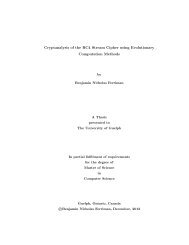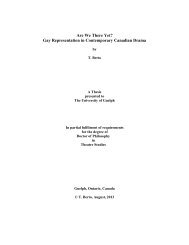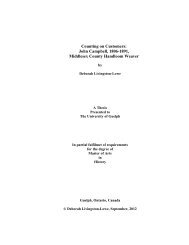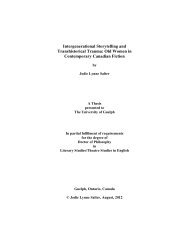THESIS - ROC CH ... - FINAL - resubmission.pdf - University of Guelph
THESIS - ROC CH ... - FINAL - resubmission.pdf - University of Guelph
THESIS - ROC CH ... - FINAL - resubmission.pdf - University of Guelph
You also want an ePaper? Increase the reach of your titles
YUMPU automatically turns print PDFs into web optimized ePapers that Google loves.
via centrifugation into four fractions known as 2S, 7S, 11S, and 15S. The 7S and 11S fractions<br />
make up 37% and 31% respectively <strong>of</strong> the total extractable protein with molecular weights<br />
ranging from 180 to 360 kDa (Wolf and Cowan 1975). These molecular weights are a good<br />
indicator <strong>of</strong> the polymer length with higher chain lengths typically translating to better<br />
mechanical properties. Some synthetic plastics such as high density polyethylene (HDPE) have<br />
molecular weights ranging from 200 to 500 kDa, which are comparable to SPI, revealing the<br />
good potential <strong>of</strong> soy protein as a replacement <strong>of</strong> synthetic polymers in certain applications<br />
(Ralston 2008).<br />
To form SPI films, the protein structures <strong>of</strong> the native state would need to be denatured<br />
to reform new configurations via new linkages within the protein molecule. Denaturation <strong>of</strong> the<br />
protein can be induced by changes in pH, electrical force, mechanical force, or heat (Fennema<br />
1996). Changing pH conditions away from the isoelectric point (4.2 - 4.6 for SPI) can cause the<br />
protein to unfold and increase solubility. Casting leverages this phenomenon by evaporating<br />
solubilized SPI solution on a flat surface forming film. Mechanical forces like pressure and shear<br />
are known to break bonds and induce flow in an extruder which is important for increasing<br />
intermolecular entanglement (Verbeek and van den Berg 2010). Heat denaturation <strong>of</strong> protein<br />
typically occurs above a certain threshold temperature. For SPI, this is generally between 65 to<br />
70 o C (Morgan 1989). As the proteins unfold, sulfhydryl and hydrophobic groups are exposed<br />
and disulfide bonds are reformed, thereby forming new structural arrangements. With the use <strong>of</strong><br />
heat, pressure, and shear, extrusion can greatly benefit the goal <strong>of</strong> denaturing SPI to reform into<br />
continuous films.<br />
5

















